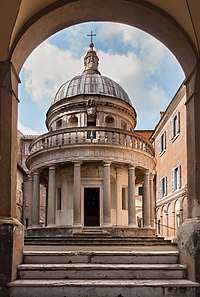Renaissance architecture

Imagine you're building a sandcastle on the beach with your friends. You start by piling up sand and shaping it with your hands. But after a while, you decide to get fancy and start adding seashells, sticks, and other decorations to make it look more impressive.
Renaissance architecture is kind of like that. In the 1400s and 1500s, people in Europe decided they wanted to make their buildings look more fancy and sophisticated. They were inspired by the art and architecture of ancient Greece and Rome, which they studied in books and ruins.
So they started designing buildings with classical elements like columns, domes, arches, and symmetrical forms. They used materials like marble, granite, and limestone to make them look more durable and impressive.
These buildings were designed to impress people and show off the wealth and power of the people who built them. They were used for things like churches, palaces, and public buildings.
Renaissance architects also started using new techniques like perspective and mathematical proportions to make their buildings look more balanced and harmonious. They were also interested in creating spaces for people to interact and socialize, such as public squares and courtyards.
Overall, Renaissance architecture is about making buildings look more impressive, sophisticated, and balanced. It's like taking a simple sandcastle and transforming it into a work of art.
Renaissance architecture is kind of like that. In the 1400s and 1500s, people in Europe decided they wanted to make their buildings look more fancy and sophisticated. They were inspired by the art and architecture of ancient Greece and Rome, which they studied in books and ruins.
So they started designing buildings with classical elements like columns, domes, arches, and symmetrical forms. They used materials like marble, granite, and limestone to make them look more durable and impressive.
These buildings were designed to impress people and show off the wealth and power of the people who built them. They were used for things like churches, palaces, and public buildings.
Renaissance architects also started using new techniques like perspective and mathematical proportions to make their buildings look more balanced and harmonious. They were also interested in creating spaces for people to interact and socialize, such as public squares and courtyards.
Overall, Renaissance architecture is about making buildings look more impressive, sophisticated, and balanced. It's like taking a simple sandcastle and transforming it into a work of art.
